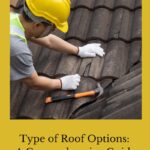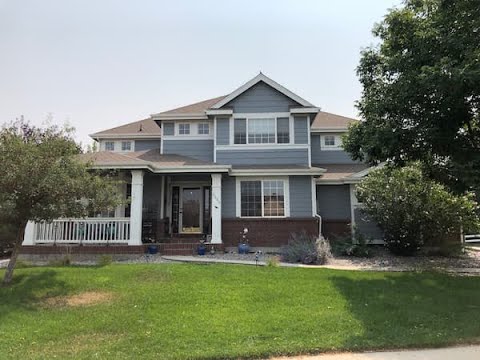Type of Roof Options: A Comprehensive Guide
Explore the various type of roof options for your home or building project. From traditional asphalt shingles to eco-friendly green roofs, this blog post covers it all. Learn about the pros and cons of each roofing type to make an informed decision for your property.
This post may contain affiliate links, I earn from qualifying purchases at no extra cost to you. Click here for my disclosure policy
In an ever-evolving world of architecture and design, roofing has transitioned from merely a protective layer to a canvas of artistic expression. As homeowners seek innovative ways to make their properties stand out, roofing trends are all about combining aesthetics with functionality. While durability and protection remain essential, there’s a growing emphasis on creating roofs that are not just practical but visually captivating.
The year has witnessed a burst of creativity in the roofing industry, offering homeowners a delightful blend of traditional and avant-garde designs. Below, we delve deep into the top decorative roofing trends that have been making waves this year.

Type of Roof Options
1. Living Roofs: A Green Evolution
The concept of sustainable living continues to shape the roofing industry. Living roofs, or green roofs, involve growing vegetation directly on the roof’s surface. These roofs don’t just look beautiful; they offer myriad benefits, from natural insulation and improved air quality to supporting local biodiversity.
2. Bold Color Palettes: Dare to Be Different
Gone are the days when roofs were restricted to neutral shades. We are now all about making a splash with vibrant colors. From vivid blues and deep greens to rich reds, homeowners are becoming more adventurous with their color choices, and the results are nothing short of spectacular.
The shift towards using metallic accents is gaining momentum, and any reputable Indianapolis roofing company would vouch for its popularity. These accents aren’t just about the shiny appeal; they merge resilience with elegance.
- Metallic Mix and Match: Combining different metals, like copper with galvanized steel, creates a contrast that stands out. These combinations offer an industrial chic vibe to residential spaces.
- Patina Finish: Over time, metals such as copper develop a unique patina. This natural aging process gives roofs a rustic and timeless charm that’s highly sought after in modern homes.
- Durability Meets Design: Beyond aesthetics, metals are known for their durability and resistance to extreme weather conditions, making them a favorite in places like Indianapolis.
3. Textured Roofs: An Ode to Artistry
This year, textured roofs have caught the fancy of many homeowners. They’re all about adding depth and dimension to the exterior. Through materials like layered slate, wooden shingles, or even dimensional asphalt, these roofs achieve a multi-layered appearance that’s both tactile and visually appealing.
4. Solar Integrated Roofing: Futuristic and Functional
As the world gravitates towards sustainable energy solutions, solar-integrated roofing systems have become a definitive trend. These are not the bulky solar panels of yesteryears. The versions are sleek, almost indistinguishable from regular tiles, and efficiently harness solar energy while complementing the home’s design ethos.
Arlington, known for its forward-thinking architectural inclinations, has seen a rise in translucent roofing installations. Arlington roofing contractors highlight this trend as one of the most intriguing shifts this year.
- Natural Light Influx: Translucent roofs allow a controlled amount of sunlight to permeate, reducing dependence on artificial lighting during the day.
- Architectural Elegance: These roofs, often constructed from materials like frosted glass or polycarbonate, add a touch of modernity to structures.
- Versatility: They can be customized in terms of opacity, color, and design, making them a versatile choice for homeowners who seek both functionality and aesthetic appeal.
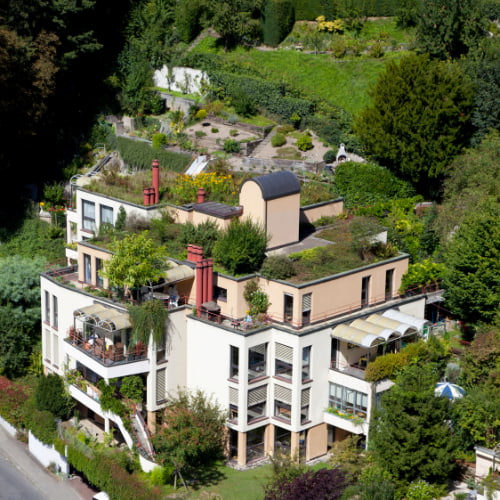
5. Roof Gardens and Terraces: Merging Indoors with Outdoors
Urban spaces are increasingly optimizing their rooftops by transforming them into gardens or terraces. These spaces are perfect for relaxation, gatherings, or even cultivation. With the right structural integrity and water-proofing solutions, roofs can be turned into serene havens overlooking the cityscape.
6. Geometric Patterns: Breaking the Monotony
Symmetry and patterns have always intrigued the human eye. Geometric patterns, be it in the form of shingle arrangement, tile design, or color interplay, are in vogue. These designs add a dynamic visual element to the rooftops, setting homes apart in the neighborhood.

7. Roofing Materials: Innovations & Choices
This year marks a shift in roofing preferences, combining aesthetics with enhanced functionality. While classics like asphalt and clay remain popular, innovative materials such as composite and rubber roofing are making headway. These new entrants promise longevity, improved insulation, and a contemporary flair, spotlighting the year’s trend toward efficient and stylish roofing solutions.
8. Custom Roofing: Your Unique Statement
The roofing landscape is characterized by personalization. Homeowners no longer seek generic solutions, desiring roofs that stand out. With advanced 3D modeling tools, contractors offer a glimpse into tailored designs, allowing homeowners to merge functionality with distinctiveness. This trend underscores the modern emphasis on roofs that aren’t just shelters but also reflections of individual style.
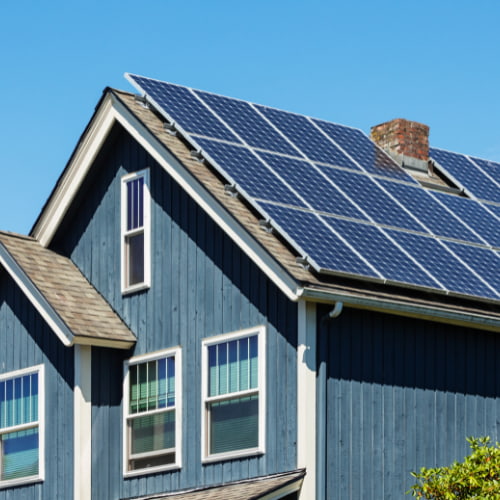
9. Sustainability in Roofing: Embracing Eco-friendly Options
The push for environmentally conscious solutions is evident in roofing trends. Green or living roofs, adorned with vegetation, are on the rise, promoting biodiversity and better insulation. Solar-integrated tiles, seamlessly harnessing energy while offering a sleek appearance, are another testament to the industry’s commitment. As homeowners lean towards sustainability, the roofing sector is adapting, blending nature with innovation.
10. Adaptive Roofing: Braving the Elements
Many have seen a surge in demand for adaptive roofing solutions, tailored to withstand diverse climatic challenges. From materials that reflect excessive sunlight in hotter regions to those offering enhanced insulation in colder climes, roofing has evolved to tackle the elements head-on. As extreme weather events become more frequent, homeowners prioritize roofs that not only look good but also offer resilience against nature’s unpredictability.
11. Roofing Tech: Digital Tools Transforming Decisions
The digital age will seamlessly integrate into the roofing industry. Advanced software allows homeowners to simulate various roofing styles, colors, and materials on a virtual representation of their homes, aiding in informed decision-making. Additionally, drone inspections provide detailed insights into roof conditions, highlighting areas needing attention. This blend of tech and tradition is reshaping how homeowners approach roofing projects, making the process more transparent and interactive.
12. Aesthetic Transitions: The Interplay of Roof and Façade
There’s a renewed focus on ensuring a harmonious transition between the roof and the home’s exterior façade. Homeowners are opting for roofing materials and colors that complement or contrast with their exterior walls, creating a unified aesthetic appeal. This trend emphasizes the roof not as a separate entity, but as an integrated component of a home’s overall design narrative, enhancing both curb appeal and architectural coherence.
13. Beyond the Surface: Roofing as a Lifestyle Statement
Each year underscores the roof’s evolution from a mere protective cover to a lifestyle statement. The choices homeowners make, be it materials, designs, or technology integrations, reflect more than just functional needs—they convey values, aspirations, and design sensibilities. As roofing options diversify, they are no longer just about sheltering the house; they are about echoing the personalities of those dwelling beneath them, making every home truly unique.
Shop any of these stores and I receive a small commission at no cost to you.
Type of Roof: Even more options
1. Exploring Different Types of Roof Options for Your Home
When it comes to the various types of roof options available for your home, there is a diverse array of choices to consider. One option to explore is flat roofs, commonly used in modern architecture and commercial buildings. Flat roofs offer unique design possibilities and can be covered with a variety of materials such as PVC, EPDM, or membrane roofing. The low-slope characteristic of flat roofs allows for efficient rainwater drainage, making them ideal for rainwater collection systems.
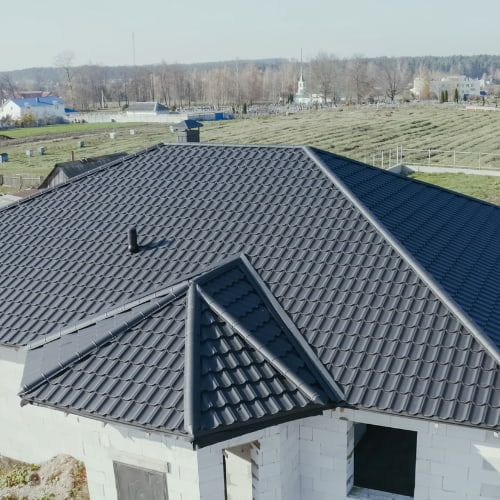
2. Standing Seam Metal Roofing: A Durable Choice for Your Property
Consider standing seam metal roofing as a durable choice for your property. Standing seam metal roofing has gained popularity due to its longevity and sleek appearance. These roofs consist of vertical panels with raised seams, which not only enhance aesthetics but also provide excellent water runoff. Standing seam metal roofing is often used in barns, commercial buildings, and modern residential designs.

3. Traditional Elegance with Wood Roofs: Cedar Shakes and More
For those seeking traditional and rustic elegance, wood roofs like cedar shakes are a timeless choice. Cedar shakes are made from natural materials, typically pine or cedar, and add a charming, natural touch to structures like cabins and Tudor-style homes. Wood roof options provide not only aesthetic appeal but also excellent insulation and energy efficiency.
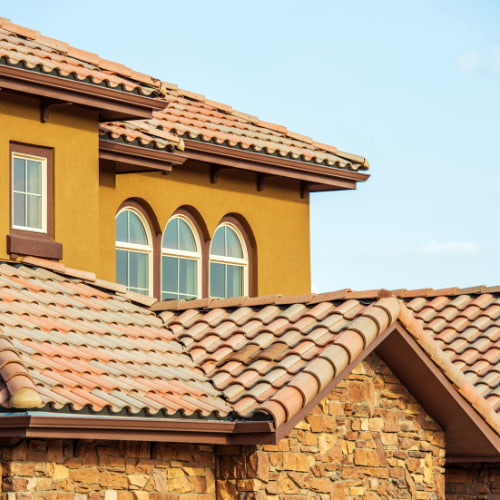
4. Tile Roofing: Mediterranean and Spanish-Inspired Beauty
Tile roofing is a common roof type seen in Mediterranean and Spanish-style architecture. These roofs can be made from various materials, including clay, concrete, or even composite shingles. The pyramid-like shape of the tiles, combined with their durability, makes them suitable for regions with heavy rainwater. Tile roofing not only offers a unique and attractive look but also stands up well against harsh weather conditions.
5. Mansard and Gambrel Roofs: Classic Roofing Choices
Mansard and gambrel roofs are variations of gable roofs often seen in older buildings and classic designs. Mansard roofs have two slopes on all sides, allowing for more upper slope space. This design offers the potential for additional attic space or even living space. Gambrel roofs, on the other hand, have a steeper lower slope and a shallower upper slope, creating more storage space beneath the roof. These classic roof types combine style with functionality.
6. Butterfly Roofs: Unique Design and Rainwater Collection
In the world of modern architecture, butterfly roofs are gaining attention for their unique, V-shaped design reminiscent of butterfly wings. These roofs not only stand out for their aesthetics but also provide an efficient way to collect rainwater. Butterfly roofs are an excellent choice for those looking to make an eco-friendly statement and harness rainwater for various uses on their property.
7. Hip Roofs: Timeless Appeal and Structural Stability
For a more classic and common roof type, consider hip roofs, which are popular in Craftsman-style homes and various other architectural styles. They feature slopes on all four sides, coming together at a single peak. This design provides a stable and sturdy roof structure while also creating an attractive exterior. Hip roofs are known for their timeless appeal and the versatility to suit a wide range of architectural preferences.

Type of Roof Q & A
What are the 4 most popular types of residential roofing?
As of my last knowledge update in September 2021, the four most popular types of residential roofing materials were:
- Asphalt Shingles: Asphalt shingles are one of the most common and affordable roofing materials. They come in various styles and colors, making them a versatile choice for many homeowners.
- Metal Roofing: Metal roofing, including materials like steel, aluminum, and copper, has gained popularity due to its durability and longevity. It can last for several decades and is known for its energy efficiency.
- Wood Shingles or Shakes: Wood shingles and shakes offer a natural and rustic appearance. Cedar and redwood are popular wood choices for roofing. While they provide a charming look, they may require more maintenance than other materials.
- Clay or Concrete Tiles: Clay and concrete tiles are known for their distinctive and elegant appearance. They are durable and can withstand various weather conditions. They are often seen in Mediterranean and Spanish-style architecture.
Keep in mind that roofing preferences can vary by region and may have evolved since my last update in 2021. It’s a good idea to consult with a local roofing expert or contractor to determine the most popular and suitable roofing options for your specific location and needs.
What is the most efficient type of roof?
The efficiency of a roof depends on several factors, including climate, building design, and individual preferences. There isn’t a single “most efficient” type of roof that applies universally. Instead, different roofing materials and designs offer varying degrees of efficiency in different situations. Here are a few considerations:
- Energy Efficiency: For energy efficiency, cool roofing materials like white or reflective roofing membranes, metal roofs with reflective coatings, or roofing materials with high solar reflectance and thermal emittance are often used in hot climates. They can help reduce heat absorption and lower cooling costs.
- Durability: The efficiency of a roof also depends on its durability and lifespan. A long-lasting roof can save you money in the long run by reducing the need for frequent repairs or replacements.
- Insulation: Proper insulation under the roof is crucial for energy efficiency. Regardless of the roofing material, having adequate insulation can help maintain a consistent indoor temperature, reducing heating and cooling costs.
- Environmental Impact: Some homeowners prioritize eco-friendly roofing options, such as green roofs or solar panels. These can help reduce a building’s carbon footprint and energy consumption.
- Cost Efficiency: The most cost-efficient roof for one person may not be the same for another. It depends on factors like the initial installation cost, maintenance expenses, and energy savings over time.
Ultimately, the choice of the most efficient roof will depend on your specific needs and circumstances. It’s essential to consult with a roofing professional who can assess your situation and recommend the best roofing solution for your goals, whether it’s energy efficiency, durability, or a combination of factors.
What are the different types of roofing services?
Roofing services encompass a wide range of tasks related to the installation, maintenance, repair, and replacement of roofs on residential, commercial, and industrial buildings. Here are different types of roofing services:
- Roof Installation: Roofing contractors install new roofs on newly constructed buildings or replace existing roofs. This includes selecting the appropriate roofing materials, underlayment, and insulation, as well as ensuring proper ventilation.
- Roof Repair: Roof repair services address issues such as leaks, damaged shingles, missing tiles, or punctures in the roof. Roofers diagnose and fix these problems to extend the life of the existing roof.
- Roof Replacement: When a roof reaches the end of its lifespan or sustains extensive damage that cannot be repaired cost-effectively, a complete roof replacement may be necessary. This involves removing the old roofing materials and installing new ones.
- Roof Maintenance: Regular roof maintenance involves inspections, cleaning, and minor repairs to prevent major issues and extend the lifespan of the roof. Maintenance services can also include gutter cleaning and moss or algae removal.
- Roof Inspection: Roof inspections are essential for identifying potential problems early on. Roofing professionals assess the condition of the roof and provide recommendations for repairs or maintenance.
- Leak Detection and Repair: Roofing contractors specialize in identifying and repairing leaks. They use various methods like thermal imaging and moisture meters to pinpoint the source of leaks accurately.
- Roof Coating and Waterproofing: Roof coatings can be applied to extend the life of a roof and improve its energy efficiency. Waterproofing services help prevent water penetration and damage.
- Skylight Installation and Repair: Roofing professionals may offer services related to skylights, including installation, replacement, and repair. Skylights can enhance natural light and ventilation in a building.
- Roof Insulation: Proper insulation helps regulate indoor temperature and energy efficiency. Roofing contractors may provide insulation services to improve a building’s energy performance.
- Green Roof Installation: Some roofing contractors specialize in installing green roofs, which involve planting vegetation on the roof surface. Green roofs offer benefits such as improved insulation and environmental sustainability.
- Solar Panel Installation: Roofing professionals may work in conjunction with solar companies to install solar panels on roofs, providing renewable energy solutions.
- Emergency Roofing Services: Roofing companies may offer emergency services to address urgent issues like storm damage or severe leaks that require immediate attention.
- Custom Roofing: In some cases, specialized roofing solutions are required for unique architectural designs or specific building needs. Roofing contractors can provide custom roofing solutions.
When seeking roofing services, it’s important to hire a reputable and licensed roofing contractor with experience in the specific type of service you require. Regular roof maintenance and timely repairs can help extend the life of your roof and prevent costly damage in the long run.
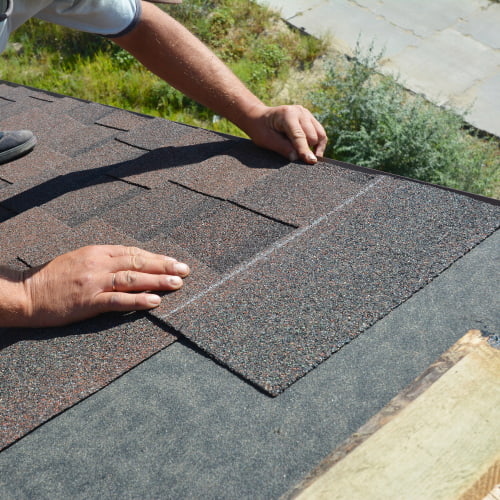
What is the cheapest roof type?
Asphalt shingles are typically considered the cheapest roofing material in terms of upfront cost. They are widely available and one of the most affordable options for both materials and installation. The cost of asphalt shingles can vary depending on factors such as the quality of the shingles, the manufacturer, and the region where you live.
Here are a few reasons why asphalt shingles are often the least expensive roofing option:
- Material Cost: Asphalt shingles are relatively inexpensive compared to other roofing materials like metal, clay tiles, or wood shakes.
- Installation: The installation process for asphalt shingles is straightforward, which reduces labor costs compared to more complex roofing systems.
- Availability: Asphalt shingles are readily available at most home improvement stores, making them easy to acquire.
- Weight: Asphalt shingles are lightweight, which means they don’t require additional structural support in most cases, further reducing costs.
While asphalt shingles are cost-effective upfront, it’s important to consider their lifespan, which typically ranges from 15 to 30 years, depending on the quality of the shingles and environmental factors. Other roofing materials like metal or clay tiles may have a longer lifespan, which can make them more cost-effective over the long term, even though they have a higher upfront cost.
When choosing a roofing material, it’s essential to consider not only the initial cost but also factors such as durability, maintenance requirements, and energy efficiency. Additionally, the cost of roofing can vary by region, so it’s a good idea to obtain quotes from local roofing contractors to get a more accurate estimate for your specific situation.

What roof covering has the longest life expectancy?
Slate roofing is renowned for having the longest life expectancy among roof coverings. Slate is a natural stone material that is incredibly durable and can last for over a century, often exceeding 100 years with proper maintenance. Here are some reasons why slate roofing has such an extended lifespan:
- Durability: Slate is a dense, non-porous, and highly durable material that can withstand various weather conditions, including rain, snow, hail, and extreme temperatures.
- Resistance to Moisture: Slate is virtually impervious to water, making it resistant to water damage, rot, and mold growth.
- Fire Resistance: Slate is naturally fire-resistant, adding an extra layer of protection to your home.
- Low Maintenance: Slate roofs require minimal maintenance over their long lifespan. Occasional inspections and repairs of individual slates may be needed, but the overall maintenance is relatively low.
- Timeless Appearance: Slate roofing has a classic and elegant appearance that can enhance the aesthetic appeal of a building, contributing to its longevity.
However, there are some important considerations to keep in mind:
- Cost: Slate roofing is one of the most expensive roofing materials, not only in terms of material cost but also installation. The high initial investment can be a significant drawback for many homeowners.
- Weight: Slate is a heavy material, and proper structural support is required. The existing roof structure may need reinforcement to support the weight of slate tiles.
- Expert Installation: Slate roofing should be installed by experienced professionals who are familiar with the unique requirements of this material to ensure its longevity.
- Fragility: While slate is durable, individual slates can be brittle and may break if stepped on or subjected to heavy impact.
Slate roofing is an excellent choice for those seeking a roofing material with exceptional longevity and a timeless look. However, due to its high cost and installation challenges, it may not be suitable for every budget or building type. Other long-lasting roofing options, such as some types of metal roofing, can also offer extended lifespans and may be more budget-friendly alternatives.
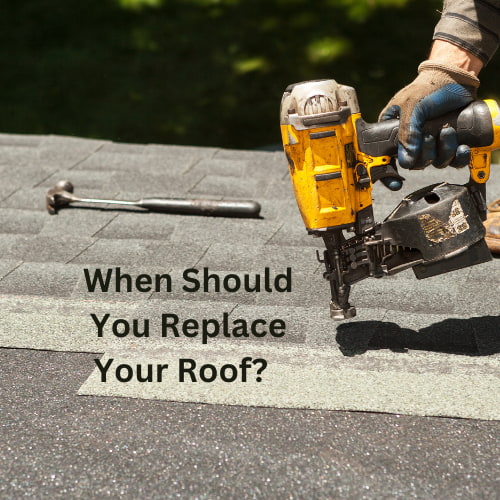
For further reading, you might be interested in reading: When Should You Replace Your Roof
Type of Roof Options: A Comprehensive Guide Conclusion
It’s evident that roofing transcends mere functionality, morphing into a canvas of artistic and personal expression. With innovative materials, technology-driven decision-making tools, and a spotlight on sustainability, the roofing trends of this year emphasize a blend of style, substance, and eco-consciousness. Homeowners are not just picking roofs; they’re curating experiences, ensuring their homes resonate with their values and visions.


